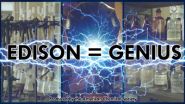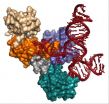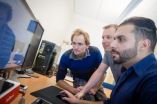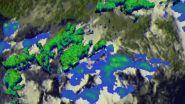(Press-News.org) Which look bigger, packages of complicated shape or packages of simple shape? Some prior research shows that complex packages appear larger than simple packages of equal volume, while other research has shown the opposite - that simple packages look bigger than the more complex. US researchers, writing in the International Journal of Management Practice believe they have resolved this dilemma.
Lawrence Garber of Elon University in North Carolina and Eva Hyatt and Ünal Boya of Appalachian State University report that human beings are just not very good at estimating the size of objects, meaning that it is often size appearance and not actual size that affects things like consumer choice. And it is aspects such as package shape and the number of packages viewed all at once that contribute to this error. The team asked volunteers to estimate the relative volumes of sets of packages whose shapes are simple or complex, presented in groups of between two and sixteen packages.
The results of this experiment demonstrate that presentation context affects a person's impression of size much more than was previously thought. "When packages are displayed in sets of nine or more, packages of simple shape appear larger than packages of complex shape," the team reports. "But, when packages are presented in sets of eight or fewer, complex packages appear larger than simple packages."
Garber and colleagues suggest that this reversal of perception means that how we estimate the volume of a given package is affected markedly by whether or not other packages are in the same "visual tableau." Moreover, the way we estimate volume of packages is flipped when the complexity of such a tableau leads to cognitive overload.
"One implication of this finding is that a package that appears smaller than another when the two are viewed sitting on a crowded store shelf, may actually appear bigger when the two are picked up and held in a consumer's hands," Garber says.
INFORMATION:
Garber Jr., L.L., Hyatt, E.M. and Boya, Ü.Ö. (2014) 'The perceived size of packages of complex vs. simple shape depends upon the number of packages presented', Int. J. Management Practice, Vol. 7, No. 2, pp.144-159.
Shape matters...
2014-06-02
ELSE PRESS RELEASES FROM THIS DATE:
Carnegie Mellon researchers discover social integration improves lung function in elderly
2014-06-02
PITTSBURGH—It is well established that being involved in more social roles, such as being married, having close friends, close family members, and belonging to social and religious groups, leads to better mental and physical health. However, why social integration — the total number of social roles in which a person participates — influences health and longevity has not been clear.
New research led by Carnegie Mellon University shows for the first time that social integration impacts pulmonary function in the elderly. Lung function, which decreases with age, is an important ...
Study suggests fast food cues hurt ability to savor experience
2014-06-02
Toronto – Want to be able to smell the roses?
You might consider buying into a neighbourhood where there are more sit-down restaurants than fast-food outlets, suggests a new paper from the University of Toronto's Rotman School of Management.
The paper looks at how exposure to fast food can push us to be more impatient and that this can undermine our ability to smell the preverbal roses.
One study, surveyed a few hundred respondents throughout the US on their ability to savor a variety of realistic, enjoyable experiences such as discovering a beautiful waterfall on ...
Gene therapy combined with IMRT found to reduce recurrence for select prostate cancer patients
2014-06-02
Fairfax, Va., June 2, 2014—Combining oncolytic adenovirus-mediated cytotoxic gene therapy (OAMCGT) with intensity modulated radiation therapy (IMRT) reduces the risk of having a positive prostate biopsy two years after treatment in intermediate-risk prostate cancer without affecting patients' quality of life, according to a study published in the June 1, 2014 edition of the International Journal of Radiation Oncology • Biology • Physics (Red Journal), the official scientific journal of the American Society for Radiation Oncology (ASTRO).
Previous prospective ...
How Thomas Edison laid the foundation for the modern lab (video)
2014-06-02
WASHINGTON, June 2, 2014 — Thomas Edison is hands-down one of the greatest inventors in history. He also had a love of chemistry that banished him to the basement as a kid. This week, the Reactions team went behind the scenes at the Thomas Edison National Historical Park to see how Edison's love of chemistry fueled his world-changing inventions. Recently named a National Historic Chemical Landmark, the complex is home to more than 400,000 artifacts (which we definitely weren't allowed to touch) and is considered the template for modern research-and-development labs everywhere. ...
Scientists capture most detailed images yet of humans' tiny cellular machines
2014-06-02
MADISON, Wis. — A grandfather clock is, on its surface, a simple yet elegant machine. Tall and stately, its job is to steadily tick away the time. But a look inside reveals a much more intricate dance of parts, from precisely-fitted gears to cable-embraced pulleys and bobbing levers.
Like exploring the inner workings of a clock, a team of University of Wisconsin-Madison researchers is digging into the inner workings of the tiny cellular machines called spliceosomes, which help make all of the proteins our bodies need to function. In a recent study published in the journal ...
Computer scientists develop tool to make the Internet of Things safer
2014-06-02
Computer scientists at the University of California, San Diego, have developed a tool that allows hardware designers and system builders to test security- a first for the field. One of the tool's potential uses is described in the May-June issue of IEEE Micro magazine.
"The stakes in hardware security are high", said Ryan Kastner, a professor of computer science at the Jacobs School of Engineering at UC San Diego.
There is a big push to create the so-called Internet of Things, where all devices are connected and communicate with one another. As a result, embedded ...
NASA's TRMM satellite sees Eastern Pacific tropical cyclone forming
2014-06-02
VIDEO:
This 3-D animated fly-by of developing tropical low pressure System 93E on June 2 revealed the highest thunderstorms (in red) as it continues to develop.
Click here for more information.
There's a new tropical low pressure area brewing in the Eastern Pacific and NASA's TRMM satellite flew overhead and got a read on its rainfall rates and cloud heights.
The eastern Pacific Ocean has become active on cue with the start of the hurricane season in that area. Only a few days ...
Laser device can detect alcohol in cars, say authors in Journal of Applied Remote Sensing
2014-06-02
BELLINGHAM, Washington, USA — A new open-access article in the Journal of Applied Remote Sensing is garnering attention for research that could aid in the campaign to prevent drunk driving: a device that can detect alcohol in cars. The Journal of Applied Remote Sensing is published by SPIE, the international society for optics and photonics.
The article "Stand-off detection of alcohol in car cabins," by Jarosław Młyńczak, Jan Kubicki, and Krzysztof Kopczyński of the Military University of Technology in Warsaw, details experiments using an external ...
Solving the puzzle of ice age climates
2014-06-02
The paleoclimate record for the last ice age — a time 21,000 years ago called the "Last Glacial Maximum" (LGM) — tells of a cold Earth whose northern continents were covered by vast ice sheets. Chemical traces from plankton fossils in deep-sea sediments reveal rearranged ocean water masses, as well as extended sea ice coverage off Antarctica. Air bubbles in ice cores show that carbon dioxide in the atmosphere was far below levels seen before the Industrial Revolution.
While ice ages are set into motion by Earth's slow wobbles in its transit around the sun, researchers ...
Seniors who exercise regularly experience less physical decline as they age
2014-06-02
COLUMBIA, Mo. –The majority of adults aged 65 and older remains inactive and fails to meet recommended physical activity guidelines, previous research has shown. However, these studies have not represented elders living in retirement communities who may have more access to recreational activities and exercise equipment. Now, researchers at the University of Missouri found that older adults in retirement communities who reported more exercise experienced less physical decline than their peers who reported less exercise, although many adults — even those who exercised — did ...




